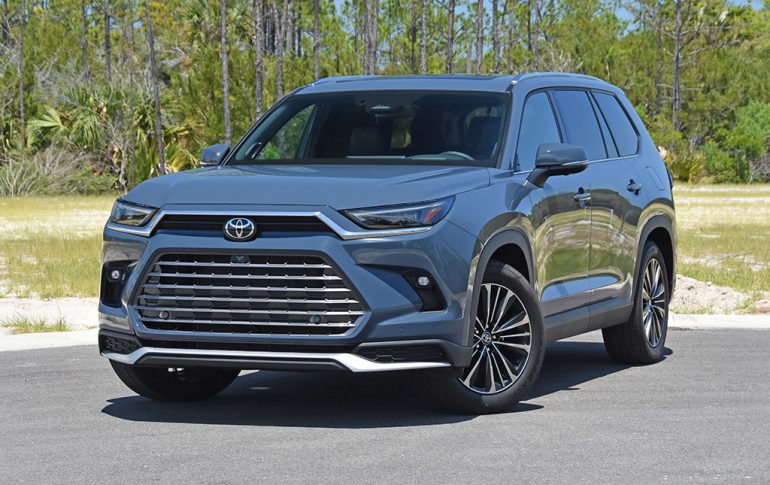
The new Toyota Grand Highlander was long overdue for the brand as there was essentially no unibody crossover from Toyota that was purposely created as a three-row seater. While the normal Highlander offered additional seats, it was simply not large enough to compete with the larger unibody 3-row crossovers, and customers had to resort to paying extra for something like the Sequoia or even the previous-generation Land Cruiser, both body-on-frame SUVs that cost considerably more. Now, the Grand Highlander takes up the space for more of a car-like driving experience in a proper 3-row unibody SUV.
Having experienced the new Toyota Grand Highlander, which is not too far from my review of the Lexus TX, I see an obvious comparison that takes place as the two share the same platform and powertrain. The experience is a surprising endeavor to discover that the Grand Highlander doesn’t take things too far down the mainstream cycle from the luxury approach of the TX. Moreover, the Lexus TX 500h F Sport Performance Luxury test vehicle I had a few weeks ago utilizes the same drivetrain as the Toyota Grand Highlander Hybrid Max Platinum, which adds to the value of the mainstream crossover. Moreover, Toyota didn’t skimp on all that the Grand Highlander offers in its top trim level, which may suffice for many who cross-shop the Lexus TX to save thousands of dollars. However, what is missing from the Grand Highlander over the Lexus TX 500h is a bit more refinement and luxury appeal, which may be well worth the additional cost, making them both a respectable value for all that they offer.
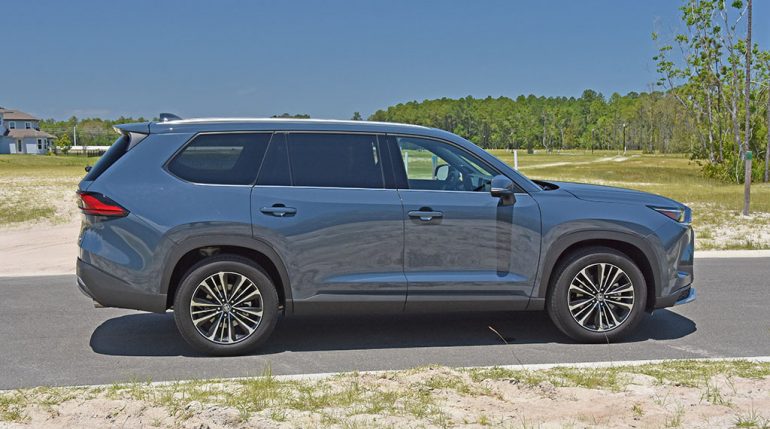
The new Toyota Grand Highlander gets a choice of 3 powertrains, with the base version being a 2.4-liter turbocharged 4-cylinder, the only non-hybrid setup, which produces 265 horsepower and 310 lb-ft of torque paired up with an 8-speed automatic transmission. From there, there is the mid-level trim hybrid variation that gets a non-turbo 2.5-liter 4-cylinder engine with an electric motor all mated to a continuously variable transmission (CVT) good for a total of 245 horsepower. My test vehicle, the Grand Highlander Hybrid Max Platinum, gets a more aggressive setup using a hybrid system, 6-speed automatic transmission, and a 2.4-liter turbocharged 4-cylinder engine with a total system output of 362 horsepower and 400 lb-ft of torque. Such a powertrain works seamlessly in its efforts to move the large Grand Highlander with authority and with an ability to hit 60 mph from a standstill in just 5.6 seconds.
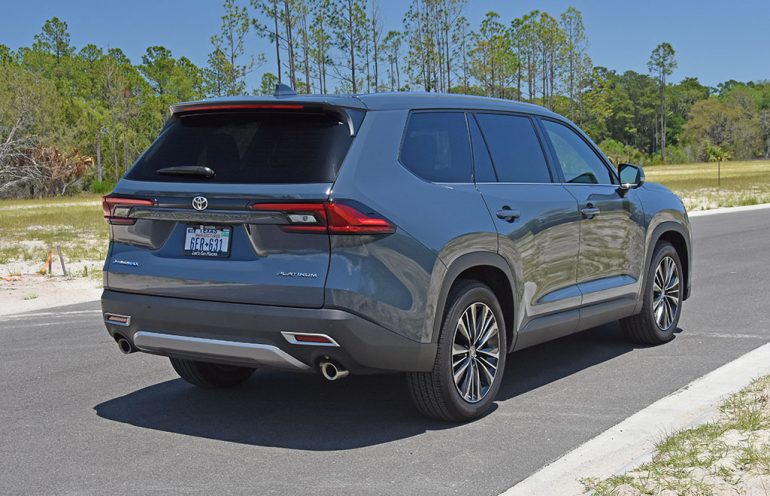
Overall, there’s an appreciation for how well the Toyota Grand Highlander Hybrid Max Platinum performs, which is more on the soft side of things but with an exceptionally smooth delivery of power when you need it. Even though the steering feel is mostly numb and the fixed-rate damper suspension is soft, there’s a welcoming aspect of its ability to surprise you on acceleration, and it does it without the expected buzzing sound of the 4-cylinder roaring to life. In fact, there’s somewhat of a low-pitched growl that you hear upon heavy acceleration.
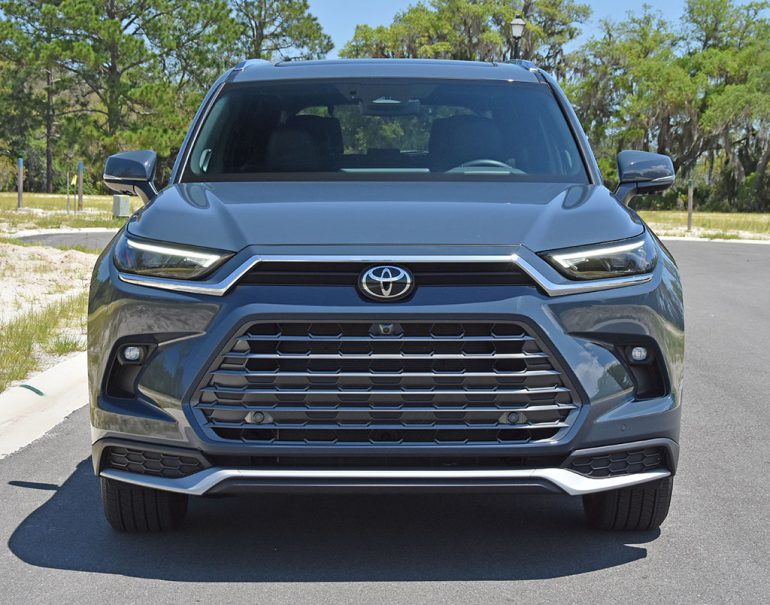
There are no unwanted surprises in the drivetrain as it smoothly shifts through its six gears when the engine is running and conducts all-electric instances upon soft acceleration powered by the rear wheels’ motor, which is not physically connected to the engine. That means its all-wheel-drive setup is unique in that the front wheels get powered by the engine, while the rears have their own electric motor fed by a 1.4 kWh battery pack.

The only disappointment in the Grand Highlander Hybrid Max’s performance was the braking feel upon heavy braking. While the brakes perform well under most conditions with a natural feel for the transition to using the regen braking to charge up the hybrid battery, heavy braking was a bit uncertain, with some imbalances in the transitions. It was nothing alarming to the point of being a safety concern, but it is at least a learning experience that makes you want to add a little more distance to the vehicle in front of you.

The hybrid system works flawlessly and adds a bit to the fuel economy factor for the level of power that the Hybrid Max system puts out. However, the overall fuel economy I returned for mixed highway and city driving came out to 25.8 mpg. The EPA estimates of 26 mpg city and 27 mpg highway are attainable but often require a conscious effort to make the most of the hybrid system by knowing how it operates. With such, it is always refreshing that Toyota offers the power gauges through the 12.3-inch digital gauge cluster to show you where you can keep use of the battery power and where the gas engine is expected to start up based on your throttle inputs. The highway range comes out to nearly 462 miles if you match the 27-mpg figure for having a 17.2-gallon fuel tank full of regular unleaded.
The vast Toyota Grand Highlander cabin accommodates well in its second and third rows of seats. The Grand Highlander doesn’t exactly mimic the Lexus TX, but many similarities are found. However, the Grand Highlander comes set up as an eight or seven-passenger vehicle, having its third row designed for three instead of just two, as in the Lexus TX. The second row can be configured with captain’s chairs or a three-seat bench at no cost.
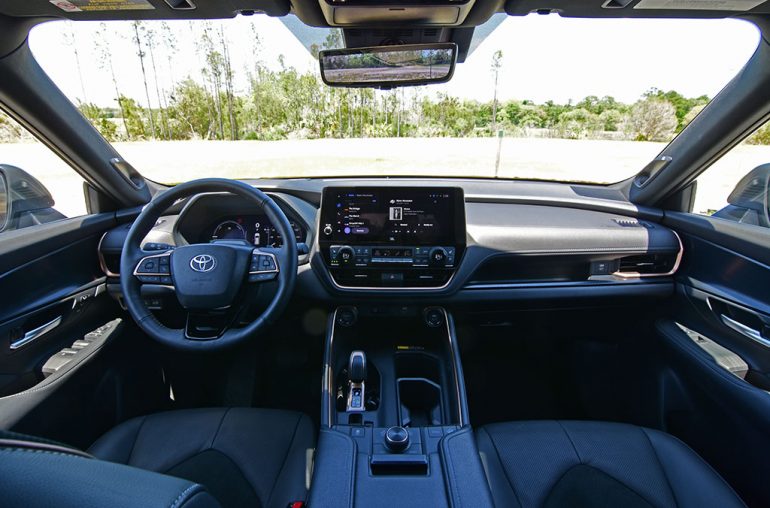
In my loaded-up Grand Highlander Hybrid Max Platinum test vehicle, there’s a seven-passenger setup with the second row having heating and ventilation in the captain’s chairs. The surprisingly accommodating third row has space like legroom at the mercy of the second-row chairs’ forward or aft manual adjustments. The front seats, heated and ventilated as well, are comfy and have a vast amount of power adjustability, with the driver’s seat having 10-ways and the front passenger with 8-way adjustability.
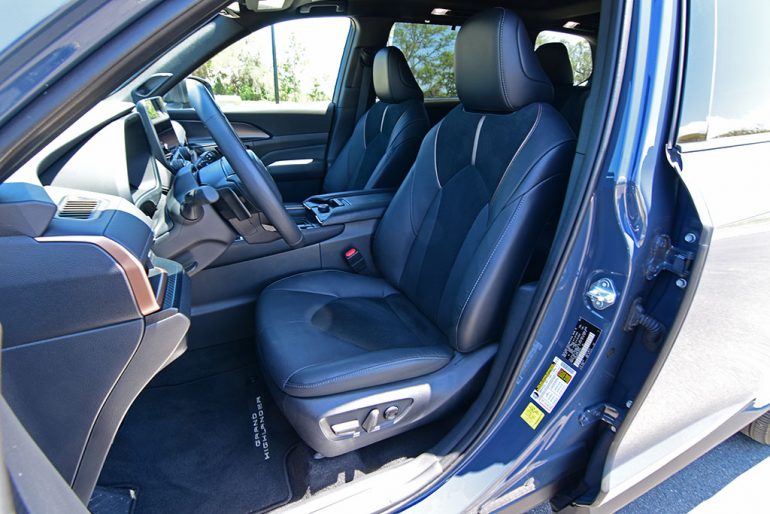
Ingress and egress are good for the third row, with the second-row captain’s chairs performing a manual forward slide and tilt maneuver, which may allow for leaving some smaller forward-facing child seats in place when accessing the third row. The 60/40-split third-row seat backs can manually fold flat to open the otherwise rather large cargo space of 20.6 cubic feet with all seats in place to as much as 97.5 cubic feet with the third and second row folded.
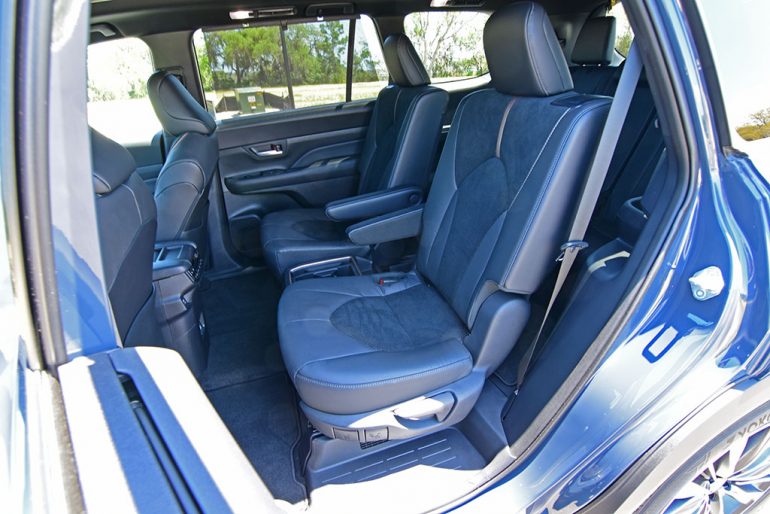
In the area of technology, the Grand Highlander in the Platinum trim gets all the goodies, which include the same recent infotainment system setup in new Toyota vehicles, which on the Grand Highlander has a 12.3-inch touchscreen. The screen, not as large as the typical 14-inch touchscreen found on some other Toyota and Lexus vehicles, is smaller due to an array of physical climate controls just below in place of what is otherwise part of the larger touchscreen. The choice for such may be a cost-saving approach but it also gives Grand Highlander buyers physical knobs and buttons for the three-zone automatic climate control system.

The infotainment unit, as expected, has wireless (and USB-connected) Apple CarPlay and Android Auto integration. The system, as explained in previous reviews, is straightforward and simple in its operation but lacks the ability to split the rather wide screen for additional functions displayed at once.

Toyota’s latest Safety Sense 3.0 setup combines all the expected active safety equipment, which includes the highlights of lane departure alert with steering assist, lane centering, lane tracing assist, blind spot monitors, forward collision warning/emergency braking, rear cross-traffic alert/emergency braking, and adaptive cruise control. The 360-degree camera system is a nice advancement in having the ability to overlay imagery of what is under the vehicle as you drive. Moreover, the front cross-traffic warning, traffic jam assist, color head-up display, digital rearview mirror, and an automated parking system add a little extra to the benefits of the new active safety tech.

The Toyota Grand Highlander is a good value for its lower trim levels in having a rather large unibody 3-row crossover, which starts at $43,320, making it a $4,000 premium over the normal Highlander. Things ramp up slightly through the trim ranges and end up going as high as $59,878, including a $1,395 destination charge for my top-trimmed Grand Highlander Hybrid Max Platinum test vehicle.

Malcolm Hogan is the founder and editor of Automotive Addicts, a trusted voice in the automotive media world for over two decades. With 20+ years of hands-on experience covering the industry, Malcolm has built a reputation for delivering honest reviews, sharp insights, and in-depth coverage of everything from new car debuts to high-performance test drives. Passionate about the evolving car culture and staying ahead of the curve, Malcolm continues to lead Automotive Addicts as a go-to destination for enthusiasts and industry insiders alike.